
Jadera haematoloma, the red-shouldered bug, goldenrain-tree bug or soapberry bug is a species of true bug that lives throughout the United States and south to northern South America. It feeds on seeds within the soapberry plant family, Sapindaceae, and is known to rapidly adapt to feeding on particular hosts. The species is often confused with boxelder bugs and lovebugs.

Elasmostethus interstinctus, the birch shield bug, is species of shield bug in the Acanthosomatidae family. Shield bugs are often called "stink bugs" because they excrete a foul smelling liquid that is used to deter predators.

Graphosoma italicum is a species of shield bug in the family Pentatomidae. It is also known as the striped bug and minstrel bug.

Dolycoris baccarum, the sloe bug or hairy shieldbug, is a species of shield bug in the family Pentatomidae.

Eurydema oleracea is a species of shield bug in the family Pentatomidae and is commonly known as the rape bug, the crucifer shield bug, the cabbage bug or the brassica bug.

Oxycarenus lavaterae, common name lime seed bug, is a species of ground bug of the family Lygaeidae, subfamily Oxycareninae.

Spilostethus pandurus is a species of "seed bugs" belonging to the family Lygaeidae, subfamily Lygaeinae.
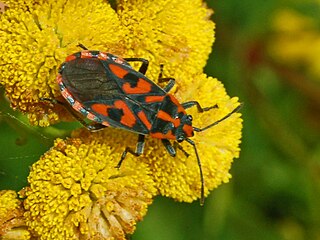
Spilostethus saxatilis is a species of bugs belonging to the family Lygaeidae, subfamily Lygaeinae.
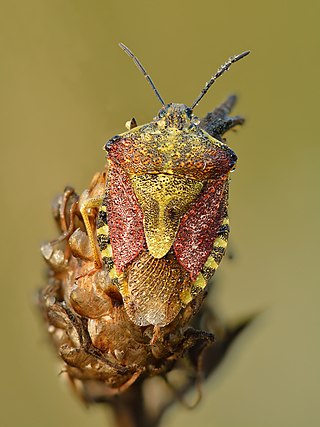
Carpocoris purpureipennis is a species of shield bug of the family Pentatomidae, subfamily Pentatominae.
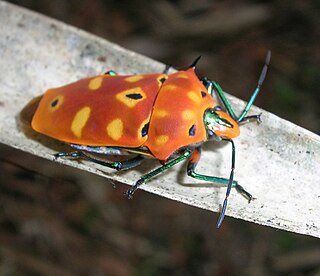
Cantao ocellatus is a species of shield bug in the family Scutelleridae found across Asia. Reddish or ochre in overall colour it has dark legs and bluish black antennae. A dark bluish black stripe is present along the central line of the head. The pronotum sometimes has two black spots on the front margin and sometimes has eight spots. The scutellum has eight or six black spots of variable size but with yellowish borders. The lateral angle of the pronotum is elongated into a curved spine but this can be much reduced. A distinctive symbiotic bacterial genus Sodalis from phylum Gammaproteobacteria is found in its midgut. Maternal care of eggs and nymphs has been noted in this species. The female stands over and covers the eggs after they are laid but eggs on the edge that she cannot cover are often parasitized by wasps.

Cercopis sanguinolenta is a species of cicadas in the family Cercopidae.

Lygaeus equestris, common name black-and-red-bug, is a species of ground bugs belonging to the family Lygaeidae, subfamily Lygaeinae.

Campyloneura virgula is a species of bugs in Miridae family. It is the only species in the genus CampyloneuraFieber, 1861.
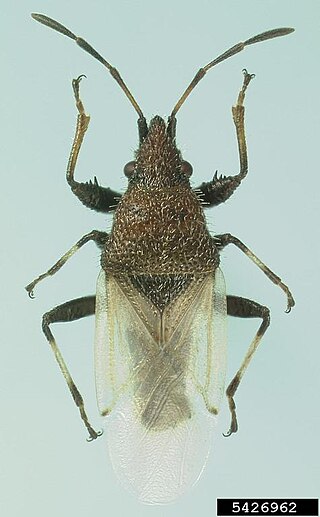
Oxycarenus hyalinipennis, common name cotton seed bug, is a species of plant bug belonging to the family Lygaeidae, subfamily Oxycareninae.

Cosmopepla lintneriana, the twice-stabbed stink bug, is a species of insect in the family Pentatomidae. Cosmopepla lintneriana was first described in 1798 by Johan Christian Fabricius as Cimex carnifex, and then again in 1865 by Thomas Say as Cosmopepla bimaculata. Cosmopepla lintneriana is hosted by a variety of plants, including milk thistle, echinacea, asparagus, oats, mint and goldenrod, and is widespread throughout North America, from Canada to Mexico. Adult C. lintneriana are black with a red, orange, or yellow band across the pronotum and a short red stripe along the midline, and two red spots at the apex of the scutellum. Nymph coloration ranges from red to white with black markings that change as they grow.
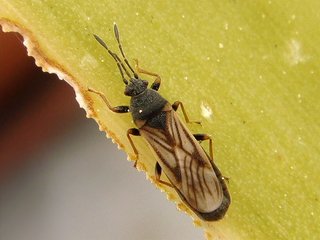
Ischnodemus sabuleti, also known as the European chinch bug, is a species of swarming true bug from the family Blissidae, which family also includes the American Chinch Bug Blissus leucopterus. It was first described by Carl Fredrik Fallén in 1826.
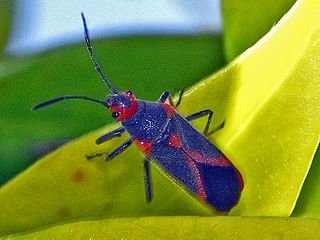
Caenocoris nerii, common name oleander seedbug, is a species of ground bugs in the insect family Lygaeidae.

Plagiognathus arbustorum is a species of insects in the family Miridae, the plant bugs.
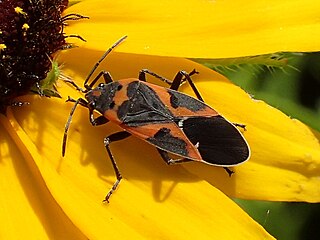
Lygaeus kalmii, known as the small milkweed bug or common milkweed bug, is a species of seed bug in the family Lygaeidae. It is found in Central and North America.

Melanocoryphus albomaculatus is a species of insect in the sub-order of true bugs, Heteroptera.























